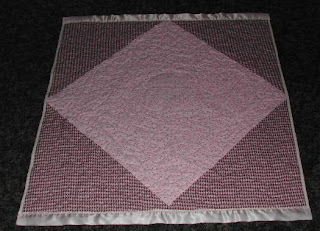I was wondering if you could make me a
costume for the Halloween party/haunted house. I want to be Hermione
Granger. In the fourth Harry Potter movie/book there is a scene
called the Yule-Ball scene. I was wondering if you could make me a dress
like the one Hermione wore. I attached a picture below. I was also
wondering if you could make me a Hogwarts School outfit. I have a white
shirt, black leggings and a striped tie. But I was wondering if you could
make me the dress/skirt thing that they wore to school. All you have to
do is cut a hole in a gigantic square.
love,
Maggie
P.S. I am 53 inches tall.I want the dress to go down past my feet. Train is optional. Maggie
(See attached Hermione Granger pictures.)
That was the email I received last week-end from my 9 year old grand-daughter. And I always am willing to help out, especially with a sewing project. So, I thought, what are my options? I checked e-bay first to see if there were any costumes already created for Hermione Granger. Sure... I found that exact pink ball dress... for $100. That wasn't happening here. There were no school outfits like the sample picture - only black cape-like costumes. I can do better than that. Next I checked the used kids clothing for any pieces that could be remade into one of these outfits. I found a few possibilities that I stuck on my watch list.
Next, I took a quick drive over to the local Salvation Army store to check on their options. Almost immediately I found a black v-neck cardigan, size 8. Perfect. The school outfit it will be; and so much easier than the pink dress. It was half-price day at the "Sally-Arm" so I paid my $1.50 and left with a smile.
Once back in my sewing room, I rifled through my kid patterns. I found a pattern that came originally from my Mother-in-Law (60's or 70's) with a gored skirt. Perfect and easy - well, easy, except for my brain fart - more about that later. Black double-knit fabric (also from my Mother-in-Law's stash) will work up perfectly.
 |
| This pattern is from the 1960's or 70's. |
I went through my bag of old ties and picked out a few for Maggie to choose from. Then it was picking trim to match the ties. (All these supplies were originally from my Mother-in-Law's stash. Yippee - I love to re-use old stuff.) I sent off an email to Maggie with pictures of different ties and trim for her to choose from. She picked the blue striped tie with the blue lace trim. Great!
Now to finish creating the costume. I took out the 2 skirt pattern pieces. One was labeled front and back panel; the other was labeled side panel. I cut 2 pieces of each, and proceeded to sew the skirt. It was basic and easy construction, so I never did read the directions. Also my 3 quilting friends were sewing at my house, so of course there was lots of conversation and distractions. (Wed. is our "Sew Therapy" session.) I held the skirt up several times as I worked and stated, "It sure seems small for size 8." I even changed the seams to 1/4" instead of the 5/8" I knew was standard in these old patterns. But Maggie is a very thin girl, so I forged on. When it was time to put in the elastic, Maggie's waist measurement was an inch or so larger than the skirt waist. Even this did not stop me. It wasn't until the entire skirt was finished - hem and all, that I decided that something just wasn't right. I opened up the directions, and it smacked me in the face immediately - This was a 6 gore skirt - not 4 gores. I needed 4 side gores - not 2! Aaaagh! Like I said earlier - a brain fart. I have no other way to explain it. I threw the skirt in the corner, and announced I would try again another day. My thought at that time was to start completely anew. However, my friends came to my rescue. They took turns ripping out all the seams. This was no easy task because it was very easy to put holes in the fabric.
 |
| 6-gored double-knit skirt with elastic waist |
The next day I cut 2 more side gores, and re-sewed the whole skirt in less than 45 minutes. It was a simple skirt after all - just maybe not as simple as I can be sometimes.
I hand basted the trim to the bottom and cuffs of the sweater, and the costume was done. All Maggie has to do is add a white shirt. It's been packaged and mailed, and I'll ask her to send me a picture of her in costume as soon as she can.
Total cost: $1.50 for the sweater plus $5.35 for postage. Getting to be involved in my Grand-daughter's life: Priceless!
 |
| Hermione Granger's School Outfit |





























